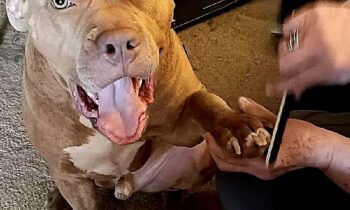
Crates and Confinement
Your puppy got used to crates and exercise pens at his breeder’s home before he left his litter to become a member of your family. Your young dog, if she is new to your household, will no doubt need to be crated or confined in an exercise pen as she adjusts to her life with you.
Crates and confinement are an integral part of raising puppies and young dogs in our current culture, and most dog owners appreciate the comfort and convenience. But what about later in the dog’s life?
Have you been tempted to put that crate away now that your puppy or young dog is housebroken? He’s no longer destructive, so you can leave him alone. She’s no longer anxious when you’re away; she’s now confident being on her own. That airline shipping kennel he used when he was younger is taking up so much space. Why not put it in the garage or give it to a neighbor?
Don’t do it!
Young dogs may outgrow the need for a crate or pen for housebreaking, but in the long doggy lifetime ahead of them (we hope), being accustomed to confinement will serve them well. In old age or infirmity, illness or injury, being comfortable in a crate could be a dog’s life-saver.
▪ Leave the crate out, where the dog can get to it.
▪ If she no longer chews inappropriately, invest in a comfy crate pad or dog bed that fits that size of crate well.
▪ Keep the door of the crate open as a default, allowing the dog to choose when to go into it, when to sleep in it.
▪ If you’re carrying treats or a favorite chew and the dog is awake in his crate, deliver a few yummy morsels or a delicious chew to him right there, like doggy room service, every now and then.
▪ Feed meals there occasionally.
Make being in that crate rewarding to your dog!

Photo by Jill Gibbs — Izzy, two months old
Elimination
Do you live with a dog in a home that has a fenced yard? Does your dog have a dog door so she can go in and out when she wishes? Does she primarily eliminate in the yard when you’re not present?
Do you live with a dog in a home that has a fenced yard but no dog door? Do you let your dog out on a schedule (generally about the same times each day) or when your dog indicates he needs to go out? Do you go outside with the dog while he eliminates or does he eliminate primarily when you’re not present?
Do you live with a dog in a home that does not have a fenced yard or confined area where the dog can eliminate? Do you walk your dog on a schedule (generally about the same times each day) or when your dog indicates she needs to be walked so she can eliminate?
Do you live with a dog in a home with a fenced yard or confined area where the dog can eliminate and you also choose to walk your dog regularly? Do you prefer that your dog eliminate at home rather than on the walk? Do you allow or encourage your dog to eliminate on the walk instead?
Why does it matter where your dog eliminates?
Why does it matter if you’re there with the dog?
Your dog will be most comfortable eliminating where and how she eliminates most often. She has been rewarded for the behavior of eliminating in that location by the feeling of relief that comes as a result. The dog that’s “done his business” in only one location all his life is at a huge disadvantage if he’s not there when he needs to “go.” Don’t limit his opportunities!
Your job as a dog owner is to give your dog the advantage of experiencing elimination in a variety of locations and circumstances when he is young, so that nothing surprises him when he’s older. His first long road trip should not be his first exposure to eliminating away from home, even if you have the luxury of a fenced yard at that home.
Don’t take chances on exposing him before he’s fully immune, but once you have your veterinarian’s approval, stock up on plastic bags and walk your young dog!
You want your dog to be comfortable with eliminating while on leash or long line—ideally, not just with you, but with someone else holding the leash. That’s right. For your dog’s future comfort, practice having other people walk him and encourage him to eliminate while on the leash. This happens naturally in families with many members, but if you live alone with your dog, ask for help from friends and relatives (the ones you might ask to take care of your dog sometime).
You won’t always be there for your dog.
You want your dog able to eliminate anyway.

Photo by Jill Gibbs — Izzy, 12 years old
Veterinary Care
Veterinary care is important—now for your puppy or young dog, in future for the dog as it ages. Do your due-diligence when choosing a veterinarian. If you’re new to an area or new to pet ownership, ask your friends and neighbors first, then take the time to read up on what each clinic offers in the way of services and referrals. Check out pet emergency clinics, too.
You and your puppy or young dog will see a veterinarian often at first, as vaccinations are completed. Take the time you have during each exam to ask questions. (Email those questions to your veterinarian several days before your appointment so he or she can be prepared with answers.) Your veterinarian and the staff at the veterinary clinic are among your most valuable resources.
Puppy classes and pet-dog classes should help prepare you and your puppy or dog for what’s to be expected in a normal veterinary visit, such as the ones you schedule to complete your pup’s vaccinations.
Veterinary examinations will be a regular event for as long as your dog lives. The more comfortable he becomes with the basics, the easier it will be for him to accept whatever care might become necessary as he gets older.
Your class instructors should offer up-to-date information and hands-on demonstrations of force-free and fear-free methods to acclimate your puppy or young dog to veterinary examinations and care, including shots and taking meds by mouth.
Practice at home what you’ve learned in class. Don’t wait until your dog’s ill or injured to introduce her to taking medications in treats, for example, when you can teach it easily long before you’ll need it. Ask your instructor to show you how to “pill” a dog just in case meds in treats aren’t practical at some time in the future. Obviously, you won’t use real medications when you’re practicing with your dog!
Muzzles
Veterinarians must muzzle dogs occasionally, for everyone’s safety. The dog may be in pain or so frightened that a muzzle is necessary while the dog is being treated. Through positive training with a slow and gentle process, dogs can become accustomed to wearing a muzzle without resistance—in fact, eagerly and without resentment.
For guidance on force-free muzzle training, ask your puppy class or pet-dog class instructor or consult an ethical, reputable force-free dog trainer for assistance.
Urine Samples
At some point in your dog’s life, you may be asked to “bring in a sample.” I guess that training your dog to be comfortable eliminating while on leash could come in handy for getting, shall we say, a solid sample, but you may need a bit more practice for the liquid.
I’ve asked two veterinarians to share the advice they’d give a novice dog owner on how best to get a urine sample from a dog. Again, it’s something that requires a bit of practice—more on the human’s part than the dog’s. Go for it!
Ruth L. Heller DVM Low tech—tape a paper cup to a yardstick and slip it under the dog. Pour into a clean jar and refrigerate until it can be analyzed, which must be within four hours at the most. First morning sample is ideal. Generally, you need maybe an ounce, although I can and have done urinalyses on much smaller samples.
Jennifer Litton Ramirez DVM When trying to collect a urine sample from your dog at home, a few things may make it easier for both you and your dog. The first thing to consider is your approach, which depends on whether you have a male or female dog.
If you have a male, it’s usually easier to slide the collection container from his side or his front (we’ll talk about the container later). For example, if your male dog urinates (pees) by lifting his leg, it’s best to use a side approach. If he squats to pee, it’s best to approach him from the front. For a female dog, it’s best to approach her with the container from behind her after she squats.
Whatever approach you use, the key is not to startle them! If they startle, then it just becomes weird for them. They won’t pee because they are wondering why you are interrupting them and chasing them with a container!
The ideal container to use is a small plastic or Tupperware-type container with a lid. It’s very important to cover the container after collection and place it in the refrigerator until you can bring the sample to your vet’s office. Ideally, the quicker you deliver the sample, the more reliable the results are.
I’d definitely practice your urine collection technique a few times with yummy rewards for your pooch as positive reinforcement before the time comes when you actually need to collect a sample.
Next week: Teaching skills to your young dog that will be useful if he becomes sight- and/or hearing-impaired in his old age.



